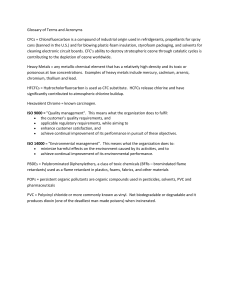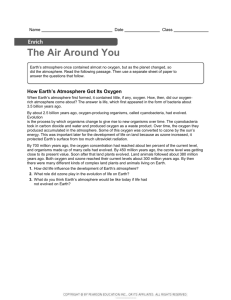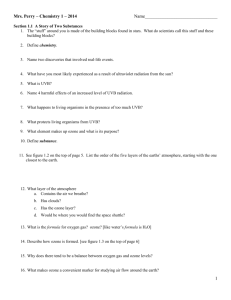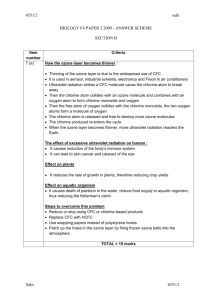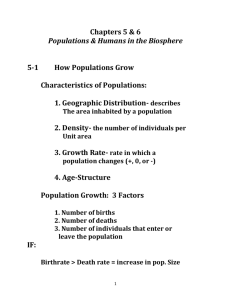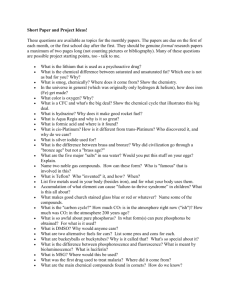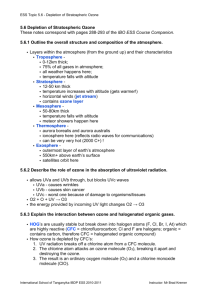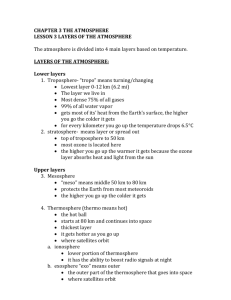Chapter 2 Questions as you read
advertisement
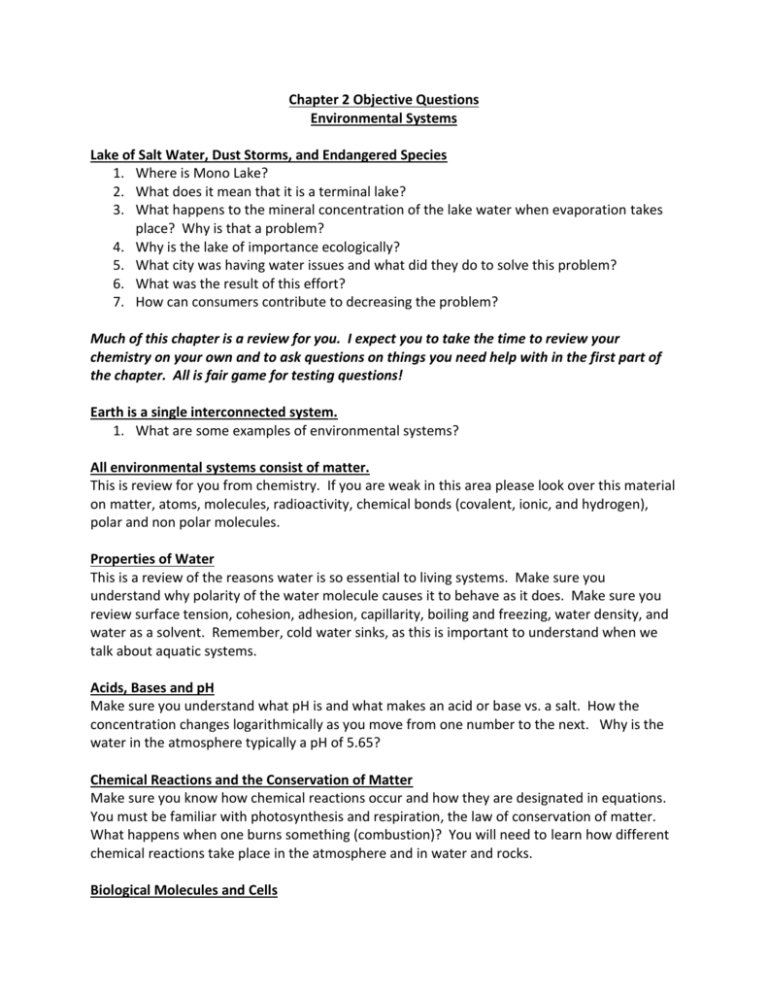
Chapter 2 Objective Questions Environmental Systems Lake of Salt Water, Dust Storms, and Endangered Species 1. Where is Mono Lake? 2. What does it mean that it is a terminal lake? 3. What happens to the mineral concentration of the lake water when evaporation takes place? Why is that a problem? 4. Why is the lake of importance ecologically? 5. What city was having water issues and what did they do to solve this problem? 6. What was the result of this effort? 7. How can consumers contribute to decreasing the problem? Much of this chapter is a review for you. I expect you to take the time to review your chemistry on your own and to ask questions on things you need help with in the first part of the chapter. All is fair game for testing questions! Earth is a single interconnected system. 1. What are some examples of environmental systems? All environmental systems consist of matter. This is review for you from chemistry. If you are weak in this area please look over this material on matter, atoms, molecules, radioactivity, chemical bonds (covalent, ionic, and hydrogen), polar and non polar molecules. Properties of Water This is a review of the reasons water is so essential to living systems. Make sure you understand why polarity of the water molecule causes it to behave as it does. Make sure you review surface tension, cohesion, adhesion, capillarity, boiling and freezing, water density, and water as a solvent. Remember, cold water sinks, as this is important to understand when we talk about aquatic systems. Acids, Bases and pH Make sure you understand what pH is and what makes an acid or base vs. a salt. How the concentration changes logarithmically as you move from one number to the next. Why is the water in the atmosphere typically a pH of 5.65? Chemical Reactions and the Conservation of Matter Make sure you know how chemical reactions occur and how they are designated in equations. You must be familiar with photosynthesis and respiration, the law of conservation of matter. What happens when one burns something (combustion)? You will need to learn how different chemical reactions take place in the atmosphere and in water and rocks. Biological Molecules and Cells Review the macromolecules you learned in biology. What makes something organic vs. inorganic? Hydrocarbons? Review the carbohydrates, lipids, proteins, and nucleic acids. Make sure you know what they are made up of and how they play a role in living organisms’ survival. Where are they found in living organisms and what elements are they composed of? Energy is a fundamental component of environmental systems. This concept is probably one of the most important concepts you need to learn about life on this planet. This is also something you have already learned about in both biology and chemistry, but let’s make sure we refresh the learning. 1. What is energy? 2. What is the electromagnetic spectrum? This is going to come into play often in this class as we will discuss the ozone layer, radiation, convection, conduction, and other energy related topics. 3. What is a joule? 4. What is power? 5. What is a kilowatt? 6. What is the difference between potential and kinetic energy? 7. What is temperature? Make sure you are familiar with Table 2.1. We will see these units later when we discuss energy conversions. You need to know how to work conversions using unit analysis (dimensional analysis), the math you did in chemistry. First Law of Thermodynamics: Energy is Conserved 1. Again, biology and chemistry and physics … review the law. It states what? 2. What is energy efficiency? Give an example. 3. What happens when chemical energy from coal is turned in to electricity? How efficient is this process? 4. What is the energy from burning coal given off as if not to make electricity? 5. How efficient is the coal then by the time it reaches the house? 6. How efficient is an incandescent light bulb when the electricity is being used by it? 7. So what does the overall efficiency end up being? 8. What is energy quality? 9. What are examples of high quality energy? Low quality energy? 10. What is entropy? 11. In what direction does energy always flow? Cold to hot or hot to cold? Energy conversion underlies all ecological processes. 1. What must living organisms do to maintain order and therefore grow, reproduce, and survive? 2. How does energy form and amount determine what kinds of organisms can live in one place or another? Systems analysis shows how matter and energy flow in the environment. 1. What is the difference between an open and a closed system? Give examples of an open system? Closed system? 2. Which system is more common? Inputs and Outputs 1. What are inputs and outputs? 2. What can a systems analysis tell us? 3. DO THE MATH of The Mystery of the Missing Salt on page 44. You will be expected to work problems such as this one on the APES exam often in your FRQ. Steady States 1. What happens when there is a steady state? 2. What is the first step in determining whether a system is in a steady state or not? 3. How can one part of a system be in a steady state and other part not? Feedbacks 1. What does the term feedback mean? 2. Differentiate between a negative and positive feedback. Which is more common? 3. Which amplifies changes and which resists changes? 4. How does warmer temperature at the Earth’s surface impact the water cycle? 5. What happens when there is more water in the air? 6. What happens to radiation when you have an increase in cloud formation? 7. How do low clouds differ from high clouds on temperature impact? 8. What is a feedback loop? 9. How do humans affect these natural cycles? Natural systems change across space and over time. 1. What are some examples of environmental conditions that might vary over time? 2. Why is it important to study changes in natural systems over time? Working Towards Sustainability 1. Where are the Everglades? 2. What has had the greatest impact of this ecosystem? 3. In what ways has it impacted the area? 4. What measures have been taken to try and correct the problems? What is an adaptive management plan? 5. Why is it a good strategy in dealing with natural systems? SCIENCE APPLIED (pp. 52-55) This is what it is all about – applying what you know. 1. What are chlorofluorocarbons, CFC’s? 2. What does the ozone layer of the atmosphere do for life on this planet? 3. How do CFC’s affect this layer? 4. What problems do living organisms have when exposed to high levels of UV-B radiation? 5. What are the three groups of UV radiation? How do they differ from one another? 6. What is an ozone molecule composed of? KNOW THESE CHEMICAL RECTIONS: 7. How does this form during the first step? The second step? 8. What impact do UV-B and UV-C have on this new molecule? 9. Under normal conditions what are these amounts like? 10. How does chlorine affect the ozone molecule? 11. So the chlorine acts as a _______________ in this reaction. 12. How many ozone molecules can one chlorine molecule catalyze to breakdown? 13. What is the resulting problem? How did nations address the ozone crisis? 1. What is the EPA and what did it do in response to this crisis? Year? 2. What was discovered in 1986 that led scientists to be concerned? 3. What problems can you see for manufacturers who use CFC’s in their products? 4. How long does chlorine stay in the atmosphere? 5. What was the Montreal Protocol and what did it stipulate? What amendments were enacted in the early 1990’s? 6. What did the Montreal Protocol demonstrate is possible when dealing with anthropogenic pollutants?
